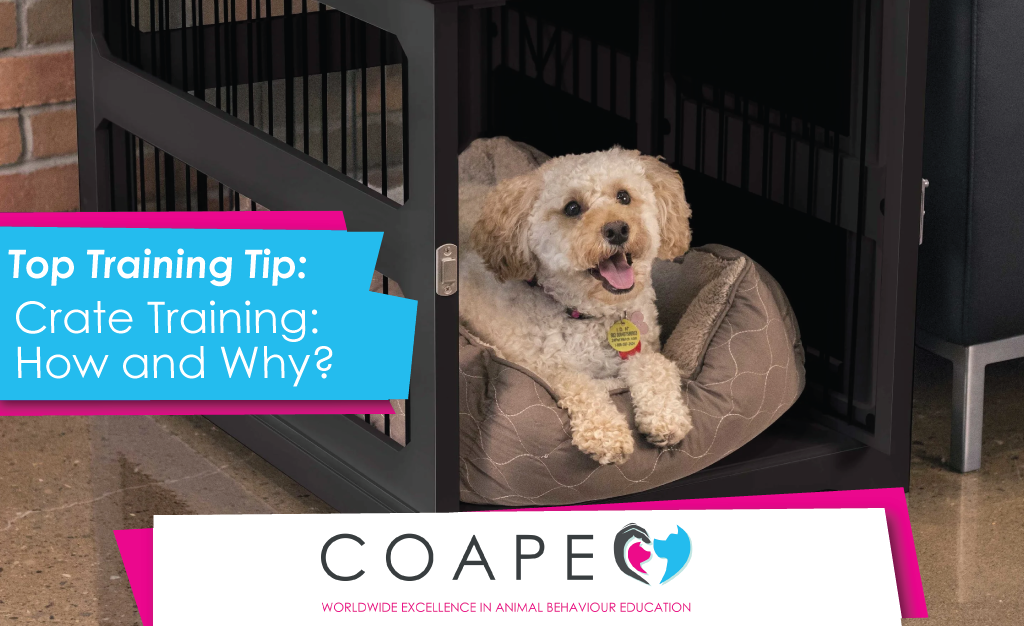Crate training is more popular in some parts of the world than in others, but there are some misconceptions about it as well. Crate training your dog is not about keeping them in a cage all day, in fact crate training can be highly beneficial to your dog and becomes their safe and happy spot.
Well known clicker trainer, Karen Pryor, agrees and says “Many people refuse to crate or kennel-train their dogs because they feel the confinement is cruel. However, a crate or kennel can give dogs a sense of security. Crate training done properly is also a highly effective management system that can be a lifesaver for dog owners. Like any training method, crating can be abused, but using a crate for appropriate time periods is helpful with a variety of important goals, including house training, preventing destructive behaviour, and teaching a dog to settle and relax.
If a dog is taught through positive reinforcement to love the crate, the crate becomes his own private and safe place, much like a bedroom for a child. The crate or kennel is somewhere the dog can go and not be bothered; it’s a perfect destination when the dog is tired or nervous. Dogs have a natural instinct to be in a den. Many dogs take to a crate very easily.”
Crate training for dogs should be done carefully to ensure your dog enjoys being in her crate, this is the most important thing.
Follow these steps to get your pretty pooch happy in her crate:
- The first step is getting a crate that is the correct size for your dog. There should be enough space in the crate for your dog to be able to lie stretched out and to stand up.
- Once you have the correct crate, place it in a quiet corner of your house. For example, crates should never be put right in the middle of the busiest part of the living room. You want the crate to be a safe and happy place. The crate should also have a comfortable dog bed inside it. You want to teach your dog that being in the crate is a pleasant experience so NEVER use the crate for punishment. The crate is going to become your dog’s safe space, and you have to make sure that there are no unpleasant associations with the crate.
- To start the crate training, start feeding your dog all her meals inside the crate. Put the food bowl just inside the door of the crate to begin with, and gradually move it to the back of the crate over the course of several meal times. Alternatively, you can take one kibble at a time and throw it into the crate. Start off with it being near the door and gradually throw it deeper into the back. The golden rule here is to NEVER force your dog into the crate. If you see she is weary of going in, keep her food closer to the door (inside the crate) until she is comfortable and then move on. As with any training, rushing her will only have negative effects. Continue this until she is happily dashing in and out of her crate to fetch her bits of food. Be sure to use lots of praise and cuddles to tell your dog you’re pleased with her.
- Now that your dog is happy to go into the crate, we need to start teaching her to stay in the crate. Put your dog’s favourite chew toy (such as a smoked pig’s ear, or a stuffed Kong™ or Hoof) into the back of the crate, leaving the door open. Encourage her to lie in her crate and chew the toy. Don’t give her this chew toy at any other place – we want to teach her that “extra yummy special chews only get chewed when I’m in my crate”. Wait for her to really relax and get comfortable while in her crate, and when she does, reward her with even more treats.
- For this step, you are going to teach your dog to stay in the crate with the door closed. Encourage her into the crate by throwing a yummy treat into the back. Close the gate and immediately start feeding her high value treats (chicken, liver, cheese) through the gate. Do not keep her in there for more than a minute to begin with. Open the door and praise your dog calmly. Do not give her treats when you open the door and keep your praise nice and relaxed. You want her to learn that the treats she gets while in the crate are better than the ones she gets when the door is opened, and she comes out.
- Repeat step 5 over several days and gradually extend the time she spends in the crate with the door closed. Never let her stay in there longer than she is comfortable with.
- Next, give your dog her high value chew toy and leave her alone in the crate for a few minutes, with you out of sight. Come back without a fuss and praise her for being a good girl. If your dog starts crying when she is in the crate and you are out of sight, give it a few seconds and see if she stops. If she doesn’t stop after 30 seconds, casually walk through the room without looking at her. This is done to reassure her that you’re still there, but she can’t come out yet. Don’t talk to her, just stroll past. Whistle when you go out of the room again, so she can hear you. Only let her out of the crate when she is not crying.
- If you see your dog going into her crate voluntarily, praise her enthusiastically and reward her with treats. Crates work really well as a bolt hole for your dog, so make it a house rule that no one bothers your dog when she is in her crate, except to reward her for being in there by giving her a treat.





